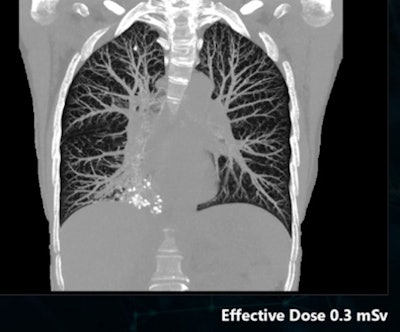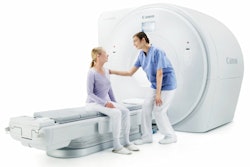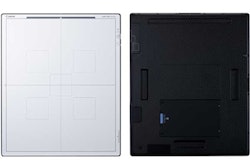
While Canon Medical Systems opted not to exhibit in person in McCormick Place, the company is still showcasing its products with a virtual exhibition. Among Canon's highlights are a new MRI scanner, deep learning-based enhancements in CT reconstruction, and a new ultrasound package.
MRI
Canon's new MRI scanner is called Vantage Fortian, and enabling users to enjoy more efficient workflow was a major goal of the company in designing the system.
The company is also discussing a new software release for its MRI family that includes iterative motion correction, reverse-encoding diffusion-weighted imaging (DWI), and expanded SPEEDER (Exsper).
Chief among the new developments is an overhead camera that can be mounted in the MRI suite, with accompanying tablet-based Tablet UX software that technologists can use to help position patients. Canon believes the package can reduce the number of people in the scanning room and improve operator efficiency by removing the need to have technologists "tethered" to a single location to control the scanner.
Another new feature, called Auto Scan Assist, applies automation to the process of planning and performing scans of the brain, spine, cardiac, and knee. The software uses deep learning and machine learning for liver, whole-spine, and prostate studies.
CT
A major highlight in the CT section of Canon's virtual booth is the extension of the company's Advanced intelligent Clear-IQ Engine Deep Learning Reconstruction (AiCE DLR) reconstruction software to all the CT scanners in the company's product line.
AiCE DLR is designed to apply deep learning to CT images to suppress noise while reducing signal. The algorithm is trained with model-based iterative reconstruction (MBIR), but it produces images that appear closer to traditional iterative reconstruction at a much lower radiation dose.
In a similar vein, Canon will demonstrate a technology called SilverBeam that enables extremely low-dose CT lung cancer screening exams to be acquired. SilverBeam is a beam-shaping energy filter that leverages the photon-attenuating properties of silver to remove low-energy photons from the x-ray beam. When combined with AiCE DLR, SilverBeam can enable the acquisition of lung screening exams at a radiation dose in the neighborhood of 0.3 mSv. SilverBeam is pending 510(k) clearance on the Aquilion One/Prism Edition scanner.
 A CT lung cancer screening image acquired with Canon's SilverBeam technology at a radiation dose of 0.3 mSv. Image courtesy of Canon.
A CT lung cancer screening image acquired with Canon's SilverBeam technology at a radiation dose of 0.3 mSv. Image courtesy of Canon.Canon is also demonstrating Precise IQ Engine (PIQE), a technique that applies deep-learning reconstruction to wide-area detectors to support superhigh-resolution images for these scans.
Canon believes PIQE can provide improved visualization of plaque to aid in characterization and reduce blooming artifacts from calcium, aiding in the assessment of in-stent restenosis and improving visualization of the lumen.
PIQE is being shown on the Aquilion One/Prism Edition scanner and is pending 510(k) clearance from the U.S. Food and Drug Administration.
Finally, the company is demonstrating its recent project to mount a CT scanner on a mobile truck for lung screening in underserved areas, as well as deep-learning spectral CT using rapid kV switching on wide-area CT scans.
Ultrasound
A new version of the Aplio scanner family called Aplio i-series Prism Edition is being highlighted in the ultrasound section of Canon's booth. The scanner includes enhancements to computing power and memory, with improved performance for Canon protocols like iBeam+, ApliPure, and superb microvascular imaging (SMI) Generation 4. It also sports improved spatial resolution, frame rates, and workflow features, according to the company.
Canon is also discussing enhancements to the usability of its technology, with improved comfort for sonographers while scanning. The company will also highlight efforts to make echocardiography easier to perform.
Interventional radiology
The big news in interventional radiology for Canon during RSNA week is the launch of a 12 x 16-inch high-resolution Hi-Def digital detector for interventional applications.
The Hi-Def detector provides more than twice the spatial resolution of conventional flat-panel detectors, according to Canon, with 76-micron resolution that's capable of resolving fine details during peripheral and abdominal interventional procedures. The technology results in resolution of 2.6 line pairs/mm (lp/mm) in standard view and 6.6 lp/mm in high-definition detector view.
The Hi-Def detectors will be made available on Canon's Alphenix interventional systems, including the Alphenix Sky+, 4D CT with Sky+, Biplane, and Core+ systems.
Canon is also discussing the combination of CT and angiography with the Alphenix 4D CT suite, which is capable of whole-organ imaging with up to 16 cm of coverage.
X-ray
In classical radiography, Canon is highlighting Omnera 500A, an autopositioning digital radiography (DR) unit, and Soltus 500, a mobile digital x-ray system.
Omnera 500A is an overhead-mount system with accompanying chest stand, and it features a restyled and larger x-ray tube head that has edge-free glass for easier cleaning and disinfection. Canon has also added new design features to the system's table, wall stand, and tube head to improve user ergonomics, while redundant tasks have been automated to reduce repetitive motion injury among technologists.
Initially launched in mid-2020, Soltus 500 sports a compact design that improves its maneuverability in hallways and critical care areas, according to Canon. The system's 40-kW generator is designed to support multiple types of exams beyond chest x-rays, and an enhanced workflow package helps users complete x-ray exams at the point of care.
Molecular imaging
The main highlight in the molecular imaging area of Canon's virtual booth is Cartesion Prime, a digital PET/CT scanner. Canon is touting the fact that the system is 100% air-cooled, and it's now available in an option with a 160-slice CT scanner, adding to the 40-slice and 80-slice configurations that were previously offered.
 A PET/CT image acquired in 2.5 minutes with Canon's Cartesion Prime PET/CT scanner with deep-learning reconstruction applied. Image courtesy of Canon.
A PET/CT image acquired in 2.5 minutes with Canon's Cartesion Prime PET/CT scanner with deep-learning reconstruction applied. Image courtesy of Canon.Canon is highlighting AiCE DLR reconstruction for Cartesion Prime for both the CT and PET components, and the company is showing PET/CT images acquired in 2.5 minutes, at 30 seconds over five bed positions.
Healthcare information technology
Canon revamped the branding for its advanced visualization offerings earlier in 2021, retiring the Vital Images brand. The company formed a new healthcare IT division called Canon Medical Informatics; the group will encompass the company's enterprise, artificial intelligence, and collaborative imaging activities.
In related news, Canon launched Altivity, a new AI-related brand that consolidates the company's activities in machine learning and deep learning technologies. The company said that Altivity will encompass its initiatives to leverage AI to help clinicians make more informed decisions, deliver faster results for more personalized patient care, and streamline workflow using AI.




















